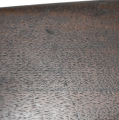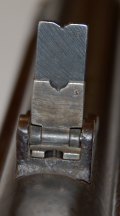site search
online catalog
CONFEDERATE “CAPTURED AND COLLECTED” US 1861 SPRINGFIELD

$2,400.00 SOLD
Quantity Available: None
Item Code: 2021-167
This Confederate-used rifle musket bears the final inspection initial/letter code of a Confederate Ordnance inspector known from other “captured and collected” arms that passed through the Confederate Ordnance “cleaning and repair” system for reissue to Confederate troops. It also fits the general profile of these guns, discussed in Knott’s ground-breaking book, “’Captured and Collected’- Confederate Reissued Firearms.” The specific inspector’s initial on this gun (“T”) is illustrated on pages 64 to 67, appearing on a Confederate-rifled U.S. M1842 and also on a C.S. Richmond.
These were weapons gathered up by CS Ordnance teams and sometimes by civilians, processed through one of several Confederate cleaning and repair facilities, and at final inspection before reissue marked with an inspector’s initial or code letter. Knott estimates as many as 200,000 captured and collected (“C&C”) firearms, with another 50,000 turned in by CS army units, went through the cleaning and repair process (hence another designation: “C&R.”) Most were from eastern battlefields that remained in Confederate hands, and included weapons of all sorts, including longarms and carbines. The list is still growing, as is the catalog of inspector’s stamps. “T” appears on the belly of the stock just forward of the triggerguard tang, the usual location of these stamps, and is among the first five cataloged by Knott at the time of publication. One, “Z,” is thought to be Louis Zimmer, of the Richmond Arsenal/ Artillery Workshop, but the others have not been identified and it is possible that letters were less systematically assigned.
The lock is clearly dated 1861 in rear of the hammer and U.S. / Springfield forward with the Springfield eagle above, though the lock was obviously scrubbed in the C&R process, softening the marks and largely doing away with the eagle. The date on top of the barrel is rubbed on the right. “18” is clearly visible, however, and it likely matches the plate. The V/P/eaglehead proofs at left breech are clear enough and seem to be Springfield. The buttplate tang bears an outlined “U.S.” that is likely from a Providence Tool Company contract rifle musket, which opens the question of whether the CS ordnance facility just needed to replace the buttplate or the stock was the problem when the gun reached the facility. We can just see the faint hint of a cartouche on the left side flat, but cannot make it out to resolve the question, but the significance of the gun is its reissue to Confederate forces as it stands now.
The metal is a muted silver or a light steel gray, with darker gray spots around the muzzle and on the nose cap, with some shallow pitting around the lower band and a few small dings. The 1861 pattern rear sight is in place and shows some thin blue, with rubbing on the edges. The bolster and top of the barrel behind the sight and near the hammer shows some pitting from firing and traces of a vise mark on the left flat. The bottom of the triggerguard shows some light pitting. The buttplate matches the other metal in color and condition, though showing more dark gray spots and dings inside the curve. The bands seem to be US, though the “U” on the upper and lower bands does not precisely line up with the band springs. The wood has good color and is tight to the metal. As mentioned above, there is a hint of a cartouche on the left, but nothing can be made out. The only damage is around the lower band, where there is some wear along the barrel and chipping at the back edge of the band on the left. The ramrod channel is generally good, with minor wear to the sides and a wear from the top band forward from the swelled shank of an 1861 rod. A collector added a reproduction M1863 rod for display, which we have left in place, but correct rods are not tough to find. Swivels, springs, etc., are all in place. The action is good. The bore is smooth, obviously having been used around the farm after the war by a Confederate veteran or Union captor.
The wood shows a little burning under the hammer, which corresponds to the scattered pitting on the top of the breech and around the cone, the effects of British high-pressure percussion caps brought in through the blockade. These were introduced in 1861 to make sure of ignition, but produced an unnecessarily violent spark, sometimes flew apart, and were discontinued in Britain in 1864, but could hardly be withdrawn from Confederate service even if they had wanted to.
This is a very good example of a Confederate-used rifle musket and shows the resourcefulness of Confederate authorities in coping with the North’s industrial superiority by establishing a system to ensure the flow of usable arms to frontline forces. It would make a great addition to a Confederate or Civil War arms collection. [sr] [ph:L]
DISCLAIMER: All firearms are sold as collector's items only - we do not accept responsibility as to the shooting safety or reliability of any antique firearm. All firearms are described as accurately as possible, given the restraints of a catalog listing length. We want satisfied customers & often "under" describe the weapons. Any city or state regulations regarding owning antique firearms are the responsibility of the purchaser. All firearms are "mechanically perfect" unless noted, but again, are NOT warranted as safe to fire.
~~~~~~~~~~~~~~~~~~~~~~~~~~~~~~~~~~~
THIS ITEM, AS WITH ALL OTHER ITEMS AVAILABLE ON OUR WEB SITE,
MAY BE PURCHASED THROUGH OUR LAYAWAY PROGRAM.
FOR OUR POLICIES AND TERMS,
CLICK ON ‘CONTACT US’ AT THE TOP OF ANY PAGE ON THE SITE,
THEN ON ‘LAYAWAY POLICY’.
THANK YOU!
Inquire About CONFEDERATE “CAPTURED AND COLLECTED” US 1861 SPRINGFIELD
For inquiries, please email us at [email protected]
Most Popular
Historical Firearms Stolen From The National Civil War Museum In Harrisburg, Pa »
Theft From Gravesite Of Gen. John Reynolds »
Cavalry Carbine Sling Swivel »
Fine Condition Brass Infantry Bugle Insignia »
featured item
BREVET MAJOR GENERAL’S COMMISSION AND G.A.R. BADGE OF SAMUEL SPRIGG CARROLL: HIS TROOPS HELPED SAVE CEMETERY HILL ON JULY 2 AND TO REPULSE PICKETT ON JULY 3 AT GETTYSBURG
Carroll was a fighting general who acquired several nicknames from his red hair along with three wounds and a number of promotions and brevets for his service on the battlefield. He received several brevets for actions in individual battles: major… (2020-894). Learn More »



























